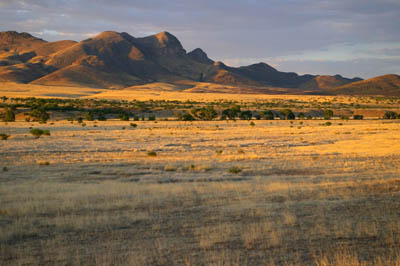
Field Institute in Environmental & Borderlands History
2009 NEH Summer Institute
for University and College Teachers
June 14-July 11
| |
| home |
| how to apply |
| venues & general information |
| preliminary detailed schedule and readings |
| housing |
| contact |
| Dear Colleagues, | There is no better time than the present to get undergraduate teachers into the field—and across borders—to learn about the cultural and environmental histories that connect the U.S. to Mexico and the world at large. Humanists have begun to devote increasing attention to the relationships that spill beyond the nation’s edge, arguing that we have become more global. And yet, we have only begun to understand in a concrete way what this means. Borderlands history and environmental history are in particularly strong positions to address this conceptual problem in two ways: they can help us to historicize our relationships to the world at large, and they can do so in a way that is uniquely grounded in a particular bioregional and cultural locale. They can help us understand how people and nature have been crossing borders for decades, if not for centuries—and they can teach us how such abstractions as the “global” take material shape, and how they work within complicated social, political and cultural contexts. This western borderlands region has long been a contested terrain, claimed and inhabited by a succession of different peoples, economies, and nations. Under pre-conquest, Spanish (1530s-1821), Mexican (1821-1854) and U.S. regimes (post 1854), the peoples of the borderlands, whether indigenous or newcomers, have shared challenging and complex environments. As two fields of historical inquiry that are especially open to interdisciplinary approaches, borderlands and environmental history provide a rich array of questions and methodologies to help us interrogate this distinct, bi-national region during the summer institute. Alongside methods traditionally used by historians to interpret textual materials, we will draw on those employed by other disciplinary practices to analyze visual materials and the landscape itself. Consider the dreary creosote-dominated landscape that characterizes the southern Arizona/New Mexico border region, for example. Although usually perceived as “natural” by visitors and residents alike, it is largely the result of overgrazing during the livestock boom of the late nineteenth century. After reading landscape descriptions from the boundary surveys of the 1850s and studying the physical indicators of overgrazing, participants will see the landscape around them in a whole new light as a product of history, as much as of nature. At one level, our summer institute will help us develop such optics and will enable us to use them in our undergraduate classrooms—even in places that seem distant from the nation’s edge. At another level, we will build on larger intellectual discussions at the forefront not only of borderlands and environmental history, but of American history in general. Indeed, scholars in both fields have had a long interest in the broader meaning and place of America. Borderlands history took shape in the early twentieth century, in an age of U.S. expansion south into Latin America—and in this context, U.S. scholars began to contemplate the nation’s historic place in the hemisphere at large. Borderlands historians such as Herbert Eugene Bolton urged colleagues to look south and link U.S. history to a greater American saga of European expansion, whereas later borderlands scholars (joined by Chicana/o historians, Native American historians, Latin American historians, and others) turned to histories of immigration, social movements, imperialism, and identity to examine what connected the U.S. to (but also demarcated it from) the rest of the Americas.
|
As borderlands historians examined issues of American cultural exceptionalism against a backdrop of hemispheric relationships, environmental historians began to pick apart myths of U.S. exceptionalism based on notions of natural abundance. Scholars such as Frederick Jackson Turner had argued that the U.S. was different from European nations because it had drawn on its subsidy of “free land” to build more democratic, progressive institutions. By the late twentieth century, however, environmental historians were telling a different tale in which imperial habits had wrought environmental destruction, forcing the U.S. to turn to new state-run efforts to manage resource scarcity and conflicts. It is this kind of perspective—simultaneously grounded and open-ended—that we will bring to bear in our summer field institute. As we anchor the study of nature and culture in place, while crossing borders to recover larger historical trajectories, we will also develop what environmental historian Dan Flores, one of our visiting faculty, calls a “bio-regional” perspective on the borderlands. For decades, in fact, scholars from a range of scientific and social-scientific fields have treated the western borderlands (and in particular, the Arizona-Sonora Desert) as a broader unit. Many of these scholars have been (and are still) associated with the University of Arizona—and it is with this unique gravity of historical interest in the arid-borderlands-as-bioregion in mind that we have chosen Tucson as our base of operations. Curiously, historians are relative newcomers to this bioregional conversation, and so our effort to raise new historical questions about nature and culture will rest partly on new cross-disciplinary conversations. Together we will read and talk to anthropologists, archaeologists, geographers, and biologists who have studied this borderlands landscape for years—and then draw on these conversations to develop new historical insights into the region that we can bring back to our undergraduate classrooms. general institute schedule >
|
|
|